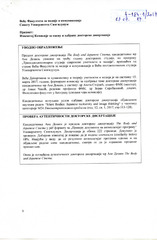Приказ основних података о дисертацији
The Body and Japanese Cinema
| dc.contributor.advisor | Stojnić, Aneta | |
| dc.contributor.other | Čekić, Jovan | |
| dc.contributor.other | Skrobanović, Zoran | |
| dc.creator | Došen, Ana | |
| dc.date.accessioned | 2017-10-31T12:34:07Z | |
| dc.date.available | 2017-10-31T12:34:07Z | |
| dc.date.available | 2020-07-04T13:16:23Z | |
| dc.date.issued | 2017-09-20 | |
| dc.identifier.uri | https://singipedia.singidunum.ac.rs/izdanje/the-body-and-japanese-cinema | sr |
| dc.identifier.uri | https://nardus.mpn.gov.rs/handle/123456789/8767 | |
| dc.description.abstract | The dissertation The Body and Japanese Cinema examines the notion of body in context of Japanese culture, specifically in a film domain. Throughout this study converging the cultural and philosophical models of both East and West, the focus is on various aspects of the body perception generated and mediated in Japan. This dissertation is the first attempt in Serbian scholarship, on Japanese cinema, to explore the corporeal perspective of Japanese identity. The first part of the dissertation features an extended analysis of the Japanese cultural outlook dealing with the questions of body and language, silence and visual space. Even though this is a study on nationally determined culture, it opposes to drawing the conclusions on the Japanese uniqueness following the Nihonjinron discourses of homogeneity. Rather, the focus is on the issues of heterogeneous taxonomy that could provide a platform for better understanding of Japanese culture as well as to offer a standpoint from which it is possible to indicate the similarities and differences of other, not necessarily national, identities. Without any intention of cultural essentialism, I argue that due to distinctive attributes and specificity of Japanese language and in addition, firmly established communicative practices that indicate intuitive understanding that goes beyond spoken words, the visceral perception is the crucial point of the Japanese film viewing. Second part of this study is a close analysis of selected movies from the filmographies of well-known Japanese cineastes. In particularly, this work proposes the taxonomy that deals with invisible aspects of the body in Japanese cinema. Chosen filmmakers whose opuses have been here reinterpreted are familiar to the audience outside Japan but their work is located on the furthest edges of mainstream, rendering them a somewhat outsider position. Here, the prominence is found in perspective that these filmmakers' attitudes resist the "official" Japan imagology which fixates the corpus of what is intended for foreigners to understand. Their body of work contrives effective communicative strategies that allow kaleidoscopic and more diverse insights of Japan. | en |
| dc.language.iso | eng | sr |
| dc.publisher | Универзитет Сингидунум, Факултет за медије и комуникацију (ФМК) | sr |
| dc.rights | openAccess | en |
| dc.rights.uri | https://creativecommons.org/licenses/by/4.0/ | |
| dc.source | Универзитет Сингидунум | sr |
| dc.subject | Japan | sr |
| dc.subject | cinema | sr |
| dc.subject | phenomenology | sr |
| dc.subject | Nihonjinron | sr |
| dc.subject | silence | sr |
| dc.subject | visceroceptiveness | sr |
| dc.subject | the invisible | sr |
| dc.subject.classification | Umetnost i mediji | sr |
| dc.title | The Body and Japanese Cinema | en |
| dc.type | doctoralThesis | en |
| dc.rights.license | BY | sr |
| dcterms.abstract | Стојнић, Aнета; Чекић, Јован; Скробановић, Зоран; Дошен, Aна; | |
| dc.identifier.fulltext | https://nardus.mpn.gov.rs/bitstream/id/60417/bitstream_60417.pdf | |
| dc.identifier.fulltext | https://nardus.mpn.gov.rs/bitstream/id/60418/bitstream_60418.pdf | |
| dc.identifier.rcub | https://hdl.handle.net/21.15107/rcub_nardus_8767 |



